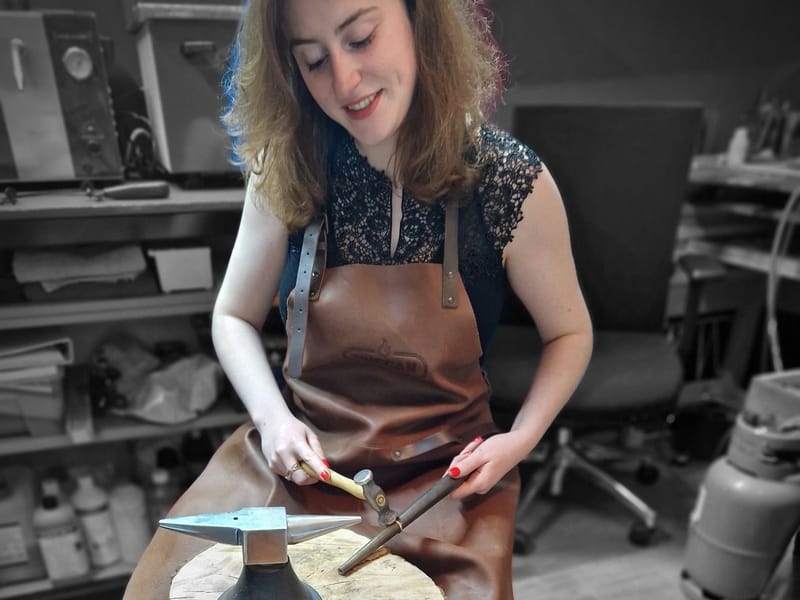Master goldsmith

Master Goldsmith
A goldsmith is a metal worker in the manufacture of jewelry and other ornamental and art objects from precious metals, such as gold, silver, platinum and palladium. Also the use of base metals, if desired think of zirconium, titanium and so on. A master goldsmith is a goldsmith who went through the process as an apprentice, then as a journeyman and finally graduated as a master in the goldsmith profession.
The goldsmith's craft
Goldsmithing has a long history. Since most metals conserve well - even after being buried for centuries - relatively many products of goldsmithing have survived from virtually all civilizations that were familiar with metal.
Techniques of a goldsmith
Goldsmiths have used the same methods of working precious metals for centuries. As a rule, these metals are processed as alloys, providing hardness, strength and durability. Making and crafting products from gold and precious metals is labor-intensive. A goldsmith works his/her metals with specialized tools, usually requiring heating of the metal.
Casting and hammering
Casting and hammering are the basic techniques used to force a lump of precious metal into a certain shape. In casting precious metals, as in bronze casting, the lost wax method of cire perdu, is used. Hammering is done with a well-polished hammer to avoid marks on the precious metal plate.
Sawing and cutting
Sawing is an operation where one removes (chips) a small amount of material with each movement of the saw. Cutting is an operation where no material is lost. In earlier days, the metal to be worked was cut with a chisel. Especially the Romans used this technique, which was later adopted by the Byzantines. This technique is not used much here anymore because it can only be applied to thin material. Nowadays, the goldsmith usually uses scissors, plate shears or guillotine shears to work sheet material. However, when cutting, the cut will deform. Consequently, this technique is not precise enough in most cases. The modern goldsmith will therefore saw his material in most cases. For this he uses a saw bracket.
Sawing and cutting
Sawing is an operation where with each movement of the saw a small amount of material is taken away (chipped). Cutting is an operation in which no material is lost. In earlier days, the metal to be worked was cut with a chisel. Especially the Romans used this technique, which was later adopted by the Byzantines. This technique is not used much here anymore because it can only be applied to thin material. Nowadays, the goldsmith usually uses scissors, plate shears or guillotine shears to work sheet material. However, when cutting, the cut will deform. Consequently, this technique is not precise enough in most cases. The modern goldsmith will therefore saw his material in most cases. For this he uses a saw bracket.
Drilling and filing
Round holes can be drilled with a variety of drills. This can be a purpose in itself, for example as decoration, but also to make a starting point in the material for a saw cut. There are many types of files in various shapes and various coarsenesses from bastard to sweet. The most familiar types are: block file, triangular file, round file, knife file, semicircular file, hinge file, barette file, roof file and the bird tongue file. Filing is a technique in which one removes (expands) a small amount of material with each stroke of the file. One files to shape something, to smooth a rough edge or to make one part fit another part of the workpiece.
Soldering and bending
Brazing is a technique for joining two or more precious metal parts. This is done by heating the parts to be soldered and letting the solder flow between them as a joining agent. This involves the use of a flux, traditionally borax. The solder is usually an alloy of a precious metal similar to that of the workpiece. If a workpiece uses base metal, it cannot be approved by a guarantee office, and therefore may not be stamped as a precious metal workpiece.
Precious metal can be bent to a desired shape. For bending, one can use tools such as pliers, tribulet or any other object with a shape that one wants to transfer to the workpiece. The metal can only be deformed to a certain extent at one time. If the metal is deformed too far, cracks will appear in the workpiece. To prevent this, one must repeatedly anneal the workpiece to relieve the crystalline structure and allow further deformation.
Modern techniques
Today, 3D printing is also among the techniques of goldsmithing. A three-dimensional drawing is created on the computer and can be printed in a special wax. Through pendulum casting (lost wax method), the model can be transformed into silver, gold, platinum, etc., among others.
Decoration Techniques
Floating is a similar technique to hammering in the basic techniques, only it is done with finer instruments to apply a decoration in the surface. In chiseling, a center punch is used instead of a ball hammer, using pitch or lead as a substrate. Engraving involves using an engraving cutter to pierce a thin piece of metal from precious metals. The object can be further decorated with such things as filigree work, enamels, inlays or setting gemstones.